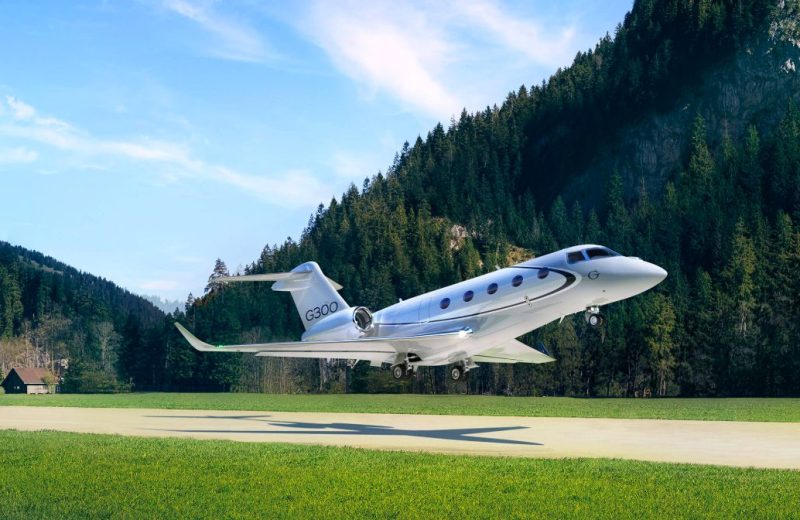G300 launch marks ‘a Gulfstream from every mission’

Aviation is a “mature” market with buyers seeking precisely the aircraft for their desired missions which is why Gulfstream has introduced the new G300, says company president Mark Burns.
Unveiling a mock-up of the aircraft at Gulfstream’s lavish Discover the Difference event at its headquarters in Savannah, Georgia, Burns said the aim is to create a “broad spectrum of airplanes from 3,600 miles up to 8,200 miles.”
The $28m G300 will replace the G280 in the super-midsize market and joins the G400, 500, 600, 700 and 800 in the Gulfstream stable, all of which have been introduced since 2014.
“In this family of airplanes we are trying to create roughly 1000 miles range difference,” adds Burns.
In Savannah, the Gulfstream president greeted guests and talked through Gulfstream’s accomplishments before turning the audience’s eyes towards a curtained-off area. Dramatic music and lights built up the suspense before the curtain dropped to reveal a G300 fuselage, surprising many in the room.
“A Gulfstream for every mission,” said Burns with a flourish. “The all-new G300 redefines the super-midsize segment and brings the large cabin features we’re so known for into the mid-cabin sector.”
He ran through features such as short-field performance, the longest cabin in the sector, swept winglets, Honeywell engines, large windows, 100% fresh air and “next generation” avionics with six touch screens in the cockpit, including an option for heads-up display. The G300 will come in eight, nine and 10 passenger versions.
“This is a very special moment for us,” added Burns.
A video showed a green jet moving around a runway. The second and third airplanes are under construction and Burns hopes the first G300 will deliver in early 2027.
“First flight is pending, we’ve put the first airplane together, we’re doing the initial taxiing,” Burns later told reporters. “You never want to rush the first flight. We’re evaluating all the safety aspects of flying for the first time.
“I’m very optimistic, with all the learning we’ve had and certification through the 400-800.”
He added that testing for the G400 is under way with about 400 hours flown. Two more aircraft will soon be added to the flight test programme to make three in total.
“I will tell you the 800 went as well as anything could go from a certification standpoint so I’m truly optimistic the 400 should go as well,” he said.
He explained the G300, like the G280, will be built in Tel Aviv, Israel, completed in Dallas, Texas, and serviced in Savannah.
The Georgia facility is home to all the company’s R&D with about 2000 engineers, plus laboratories and simulators.
It also hosts the design team that pens interiors for the full fleet.
“So you can see the styling and engineering in one has a little bit of a connection in the other airplanes,” said Burns.
On the G300 he added: “The architecture, the thought process and the switchology is very similar to the larger aircraft.”
That “commonality” provides greater efficiencies and was a common theme around Gulfstream’s service centres and production facilities near Savannah Hilton Head International Airport.
An investment in robotics has also increased productivity by 20%, according to John Kenan, senior vice president, Operations.
On a tour of the wing shop, which assembles wings for all models from the G400 upwards, Kenan explained that Gulfstream has made more than 1,000 wings since opening the facility in 2012.
It takes about two and a half manufacturing days for a wing to travel through the shop.
“If you’re building 150 aircraft a year you’ve got to kick them off to keep it moving,” said Kenan.
Over in Building Z, two parallel production lines produce the G500 and G600 (and soon to be G400). Kenan says it takes five manufacturing days for a G600 and seven for a G500 to go through the shop.
“We do everything but put fuel in it and fire the engines,” he said.
Asked when a new buyer could take delivery of an aircraft he grinned and said: “We have a very healthy backlog.”
At one of Gulfstream’s two service centres in Savannah, Lor Izzard, senior vice president, Customer Support described the company’s investment of about $500m on the service side in the last 10 years as an “incredible expansion”.
That includes 24 “fast” teams around the world, training, airborne customer support and global parts hubs, notably in Amsterdam and Singapore.
Each of four service hangar spaces can accommodate about 12 large cabin slots, for Chapter 5 work, drop-ins and heavy maintenance. The installation or upgrade of onboard connectivity is a common request. Starlink is popular but Izzard says he welcomes competition in the WI-FI space. “It gives the customer more choice. It’s good for the industry,” he says.
On the general outlook for the aviation market, Burns is upbeat, describing a mature and growing market worldwide.
“When I started at Gulfstream over 43 years ago we mostly sold airplanes here in the US and now we sell airplanes in every corner of the world,” he said.
“The tariffs were thought to be a headwind, but I haven’t really seen that in the actual purchasing of airplanes at this point right now. There is momentum for us and that continues through the end of the year.”
He described bonus depreciation in the US, introduced as part of President Trump’s One Big Beautiful bill, as a “tailwind for us”.
“It’s a really good advantage,” he said.







